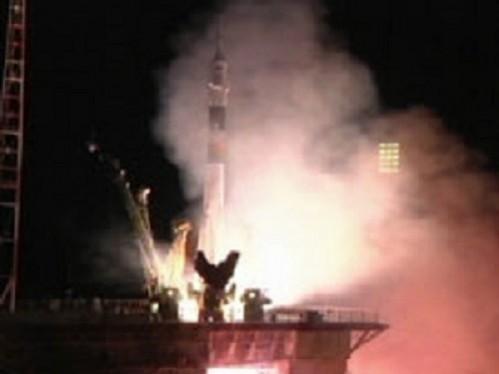
Three new Expedition 36/37 crew members arrived at the International Space Station (ISS) and docked with the Rassvet module around 10:10 pm EDT Thursday (around 8 a.m. IST).
Earlier, the Soyuz spacecraft carrying three crew members - Fyodor Yurchikhin of the Russian Federal Space Agency (Roscosmos), NASA astronaut Karen Nyberg and European Space Agency (ESA) astronaut Luca Parmitano - blasted off from the Baikonur Cosmodrome in Kazakhstan at 2.30 am IST on Tuesday (4:31 pm EDT).
The trio arrived at the space station in less than or about six hours. The Soyuz spacecraft took a shortcut that slashed down the travel time from two days to six hours. Russian engineers have developed new flight procedures which calls for the capsule to orbit the Earth only four times, in a bid to reduce the amount of time the space crew has to spend in the cramped spacecraft, reported Space.com.
This is the not the first time that a space crew has taken the fastest route to the space station. Earlier, one manned capsule and several other unmanned cargo ships have taken the fast route to the space station.
On arrival at the space station, the Soyuz capsule was docked with the Rassvet module. The space trio joined Flight Engineer Chris Cassidy of NASA, Commander and Russian cosmonaut Pavel Vinogradov, and Flight Engineer Alexander Misurkin of Roscosmos who have been aboard the space station since 28 May. Yurchikhin and Nyberg have both visited the space station before. But this is the first trip for Parmitano, a major in the Italian Air Force.
All six crew members of the expedition took part in a welcome ceremony with family members and mission officials who were gathered at Baikonur. Expedition 36 will operate as a full six-member crew until September when three members - Cassidy, Vinogradov and Misurkin - will return to Earth. The return of the trio will mark the end of Expedition 36 and the beginning of Expedition 37. Yurchikhin will take over as commander from Vinogradov.
After the return of Expedition 36 crew members, Expedition 37 will remain as a three-member crew till the last week of September when three more members would be launched from the Baikonur Cosmodrome to the space station.
Till then, the six-member crew has been scheduled to conduct five spacewalks and research experiments during their stay. The crew will perform the spacewalks to build the complex so as to install the Russian Multipurpose Laboratory Module in December. They will also conduct a spacewalk on 9 November to take the Olympic torch outside.
During their five-and-half month stay, the crew will also welcome the arrival of cargo spaceships including European Space Agency's "Albert Einstein" Automated Transfer Vehicle-4 in June, a Russian Progress cargo craft in July and the Japan Aerospace Exploration Agency's H-II Transfer Vehicle-4 in August, NASA said in a statement.
The station crew will also be involved in various research and technology experiments. Among them would be the Hip Quantitative Computed Tomography (QCT) experiment, which will evaluate countermeasures to avoid the loss of bone density during long-duration space missions. The study will also help in the understanding of osteoporosis. The crew will also conduct a research on growth of plants in space, which would eventually help future crews on growing their own food in space.















